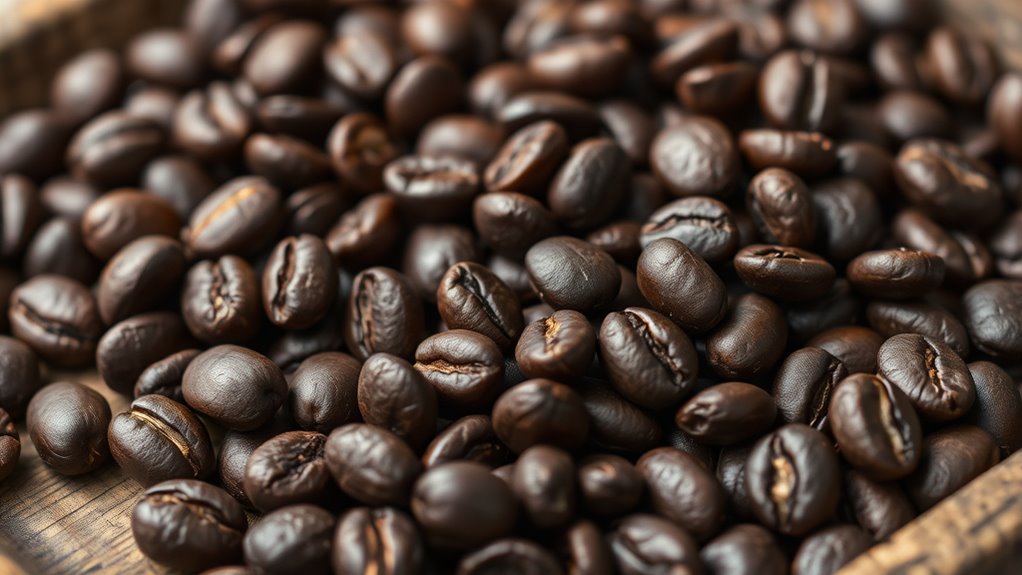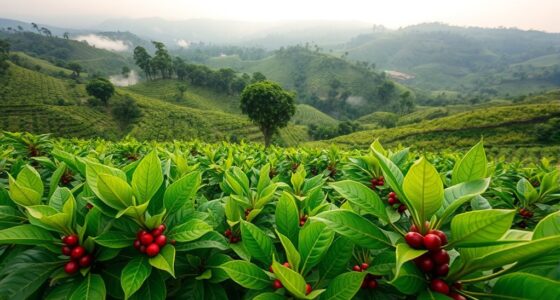Indian Monsooned Malabar undergoes a unique processing method that exposes the beans to sea winds and high humidity during monsoon season. This natural weathering, lasting 12 to 16 weeks, causes the beans to swell and develop a distinctive earthy, woody, and chocolatey flavor with low acidity. The process also makes the beans larger and lighter, affecting their roasting and taste. To discover more about this fascinating technique, keep exploring how nature crafts this exceptional coffee.
Key Takeaways
- Monsooning involves exposing beans to sea winds and humidity for 12-16 weeks, mimicking sea voyage aging.
- The process causes beans to swell, lighten in color, and develop a distinctive earthy, woody flavor profile.
- Natural weathering from sea air imparts herbal undertones and a low-acidity, full-bodied taste.
- Traditional method leverages India’s monsoon climate to create consistent, naturally aged flavor qualities.
- This unique processing enhances coffee complexity, aroma, and overall quality through natural environmental effects.
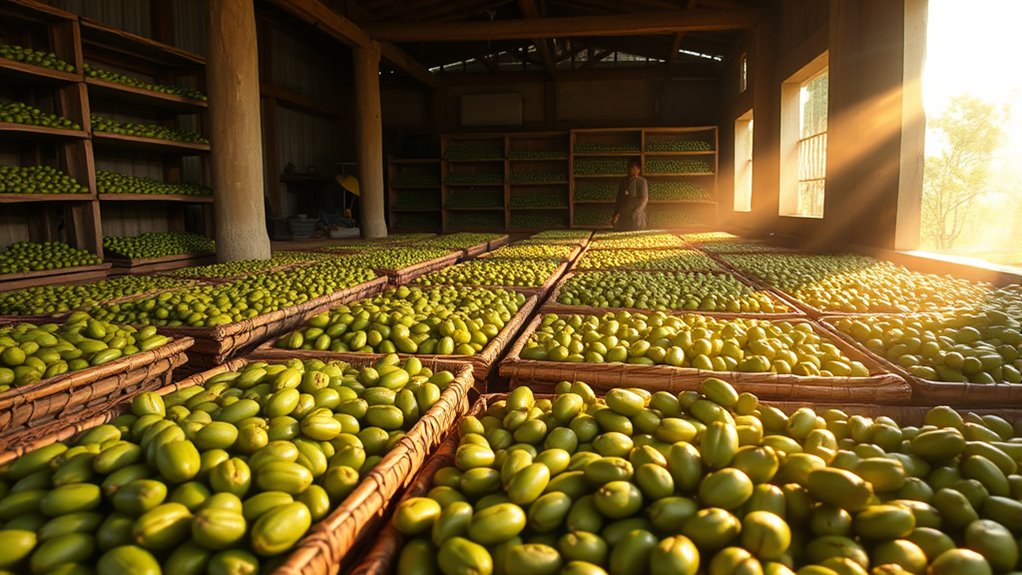
Indian Monsooned Malabar is a unique coffee variety that undergoes a traditional weathering process to develop its distinctive flavor. This process, known as the monsooning process, exposes the beans to the powerful sea winds and high humidity during the monsoon months in India.
As the beans are left to sit for 12 to 16 weeks, they absorb moisture from the surrounding sea air, which causes them to swell and change in appearance.
During this period, the beans are subjected to the natural elements of the sea voyage, mimicking the aging effects that would occur during long sea journeys from India to Europe. The sea winds carry moisture that penetrates the beans, resulting in a gradual transformation of their flavor profile.
During the sea voyage, moisture-laden winds transform the beans’ flavor and appearance naturally.
The traditional weathering process not only affects the beans’ size and color but also influences their internal characteristics. The beans become larger, lighter in color, and develop a low density, which impacts how they roast and how their flavors are extracted.
As the beans absorb moisture from the sea air, they undergo chemical changes that lead to a unique earthy, woody, and chocolatey profile. This distinctive flavor is a hallmark of Monsooned Malabar coffee, with almost no acidity present.
The exposure to sea winds and humidity imparts a characteristic earthy aroma and herbal undertones that are hard to replicate with other processing methods. This natural weathering method not only enhances the depth and complexity of the coffee but also ensures a consistent flavor profile, leveraging the climate conditions during the monsoon months.
The traditional weathering process is a carefully managed stage that has been practiced for generations in India. It’s a natural method that leverages the climate conditions during the monsoon months, making it an integral part of the coffee’s journey from farm to cup.
The influence of sea air during this period ensures a consistent and distinctive flavor profile, setting Monsooned Malabar apart from other coffees. When you brew this coffee, you’ll notice its low acidity, full-bodied texture, and complex earthy notes that reflect its unique processing heritage.
This method highlights how nature’s elements—sea winds, humidity, and sea voyage—can craft a truly exceptional coffee experience.
Frequently Asked Questions
What Is the Process of Monsooned Malabar Coffee?
You start by freshly processing the coffee beans, then store them in ventilated warehouses during the monsoon season.
Over 12 to 16 weeks, the high humidity and sea winds cause the beans to absorb moisture, swell, and change color from green to pale gold.
You regularly rake and turn the beans to guarantee even aging, resulting in a distinctive earthy flavor, low acidity, and a smooth, rich body perfect for brewing.
What Does Indian Monsoon Malabar Coffee Taste Like?
You’ll notice that this coffee has an earthy, woody, and smoky flavor with almost no acidity. It offers rich cacao and nutty undertones, along with a spicy, herbal aroma reminiscent of timber and earth.
When brewed, it delivers a smooth, heavy body with a creamy texture, creating a bold, robust cup. Its complex flavor, enhanced by natural weathering, gives it a unique, wild character unlike other coffees.
How Much Caffeine Is in Monsoon Malabar Coffee?
You might wonder about caffeine in Monsooned Malabar coffee. It typically contains about 1.2% to 1.5% caffeine by weight, similar to other Arabicas.
An 8-ounce cup usually delivers 80 to 120 milligrams of caffeine. Keep in mind, the caffeine level depends on the bean variety and roast level.
Its low acidity and smooth profile can make the caffeine feel milder, but the amount remains comparable to other specialty coffees.
Is Monsoon Malabar Arabica or Robusta?
You’re asking whether Monsooned Malabar is Arabica or Robusta. It’s primarily made from Arabica beans, especially the Catuai and Cauvery varietals, processed through the monsooning method.
However, there’s also a Robusta version that undergoes the same weathering process. Both types develop earthy, herbal flavors and larger beans, but the Arabica version is more common and valued for its smooth, chocolatey profile.
Conclusion
You now see how Indian Monsooned Malabar’s unique processing sets it apart. By exposing the beans to monsoon humidity, it develops a distinctive flavor profile that coffee lovers cherish. This traditional method not only preserves the beans’ freshness but also enhances their complexity. So, next time you enjoy a cup of Malabar coffee, remember the special journey it took through monsoon exposure, making every sip truly exceptional and memorable.
